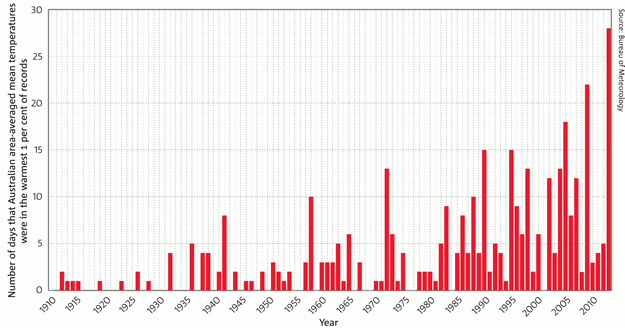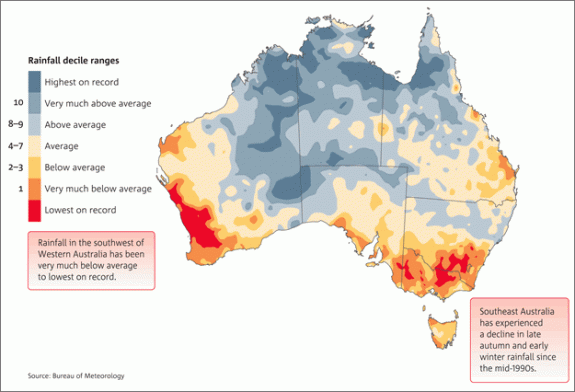News•March 4, 2014
Australia in for Hot Days, Higher Fire Risk, More Droughts
By Paul Farrell, The Guardian
Australia’s temperature will continue to warm leading to decreases in rainfall in southern Australia, increasing numbers of hot days, higher fire risks, and more severe drought conditions, according to the 2014 State of the Climate report.
The report is a joint undertaking by the CSIRO and Bureau of Meteorology, and found that Australia’s temperature is predicted to rise by 1°F to 2.7°F by 2030; in comparison, between 1910 and 1990 the temperature rose by 1°F.
Number of days each year where the Australian area-averaged daily mean temperature is above the 99th percentile for the period 1910–2013.
Credit: Bureau of Meteorology

Both the length of the fire season and the risk of extreme fire weather has also increased since the 1970s. The level of rainfall has seen a gradual decline, with a 17 percent drop in winter rainfall in southwest Australia since 1970, which the report predicts will lead to more frequent and severe droughts.
“While natural variability likely plays a role, a range of studies suggest ozone depletion and global warming are contributing to circulation and pressure changes, most clearly impacting on the southwest. Uncertainties remain, and this is an area of ongoing research. ” the report says.
The map shows the trends in extreme fire weather days (annual 90th percentile of daily FFDI values) at 38 climate reference sites. Trends are given in FFDI points per decade and larger circles represent larger trends. Filled circles represent trends that are statistically significant.
Click image to enlarge. Credit: Bureau of Meteorology

The report says a reduction in global greenhouse gas emissions would “increase the chance of constraining future global warming”.
“The duration, frequency, and intensity of heat waves have increased across many parts of Australia, based on daily temperature records since 1950, when coverage is sufficient for heat wave analysis. Days where extreme heat is widespread across the continent have become more common in the past twenty years,” the report says.
Southern wet season (April-November) rainfall deciles since 1996. A decile map shows the extent that rainfall is above average, average, or below average for the specified period, in comparison with the entire rainfall record from 1900.
Click image to enlarge. Credit: Bureau of Meteorology

The chief executive officer of the Climate Institute, John Connor, said the report showed the government needed to accept the risks of failing to act on climate change.
“The government’s self-identified ‘primary advisers’ on climate, BoM and CSIRO today clearly linked carbon emissions, climate change, fire, and drought in stark contrast to their own reluctance to do so,” he said.
“This report from the government’s primary climate advisers should put an end to the reluctance of our political and business leaders to accept the risks and costs to Australia of inadequate climate action.”
Reprinted with permission from The Guardian.
